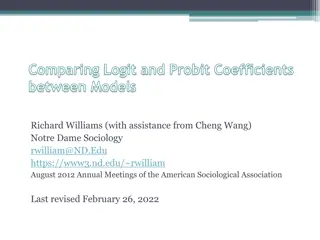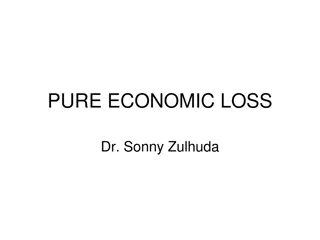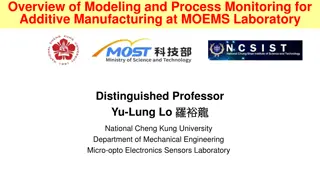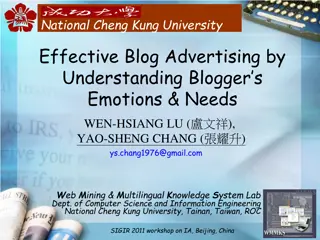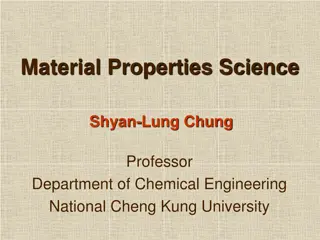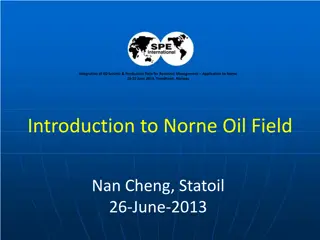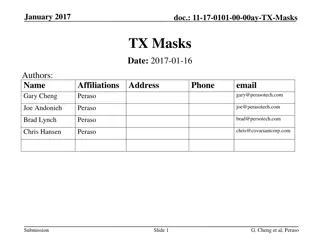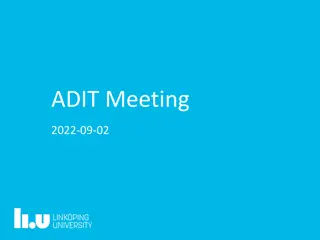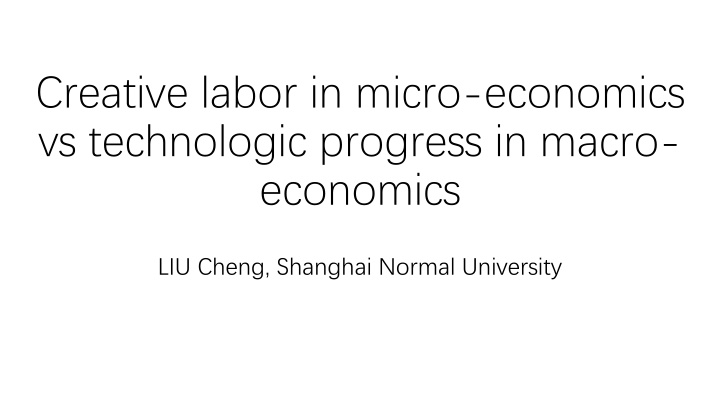
Analysis of Creative Labor in Economic Theories
This analysis delves into the distinction between creative labor in microeconomics and technological progress in macroeconomics. It reviews historical economic theories, emphasizing the importance of creative labor and technological advancements in driving economic growth. The discussion covers labor theory of value, division of labor, management innovation, and technological progress as key factors influencing surplus value and economic development.
Download Presentation

Please find below an Image/Link to download the presentation.
The content on the website is provided AS IS for your information and personal use only. It may not be sold, licensed, or shared on other websites without obtaining consent from the author. If you encounter any issues during the download, it is possible that the publisher has removed the file from their server.
You are allowed to download the files provided on this website for personal or commercial use, subject to the condition that they are used lawfully. All files are the property of their respective owners.
The content on the website is provided AS IS for your information and personal use only. It may not be sold, licensed, or shared on other websites without obtaining consent from the author.
E N D
Presentation Transcript
Creative labor in micro-economics vs technologic progress in macro- economics LIU Cheng, Shanghai Normal University
I. Introduction The current macro economic theories economic theories. Mainstream economics recognizes the role of creative labor in the form of technological progress in macro-economics, but denies it in micro-economics. macro- -economic theories are out of line with micro economic theories are out of line with micro- - So we should review the history of economic theories review the history of economic theories to trace back to the common ground of different theories, i.e., the commonness of the labor theory of value. Besides, such new classification of labor as creative labor new classification of labor as creative labor and repeating labor and repeating labor rather than simple labor and complicated labor or physical labor and mental labor is also needed.
II. History Review To summarize the theories of William Petty, Adam Smith & Karl Marx, etc., it s easy to find that wealth (value) result of the combination of labor and natural resources. To review the history of economic growth, it's also easy to find that the results of creative labor division of labor division of labor (The independence of animal husbandry & fishery can utilize natural resources better, specialized division of labor & independence of commerce can utilize human resource better) , management innovation shifts can fully utilize the machines), and technological progress technological progress (Technological progress can improve productivity), is the only source of the rate of surplus value-Smith has already found that specialized division of labor could improve productivity, and nearly all economists including Marx recognize that technological progress contributes to economic growth. To conclude, creative labor is the only source of the rate of surplus value creative labor is the only source of the rate of surplus value in micro-economics, and technological progress is a form of creative labor in macro-economics. wealth (value) is the the results of creative labor, including social social management innovation (Three 1. Wealth (value) is the result of the combination of labor (live labor & materialized labor) and natural resources 2. The results of creative labor is the only source of the rate of surplus value --My paper A Study on Laws of Economic Growth and Its Distribution (2003). 3. All forms of creative labor contribute to economic growth --Creative Labor 1: Engineering Innovation ( technological progress)-New technology --Creative Labor 2: Management Innovation- New methods resource (specialized division of labor) & other resources (three shifts, etc.) --Creative Labor 3: Institutional Innovation- New institutions New technology New methods to utilize natural resource (social division of labor), human New institutions to liberate human creativity & favor Innovation spreading
III. Micro-economic Analysis 1. Labor theory of value 1: we might as well call it Division theory of value Adam Smith-Specialized division of labor division of labor can improve productivity- Specialized division of labor is the result of creative labor. the result of creative labor. Other kinds of creative labor are neglected, including technological innovation. including technological innovation. 2. Labor theory of value 2: we might as well call it Repeating labor theory of value Karl Marks-Materialized labor can only transfer value rather than create it; only live labor labor can create surplus value-that s the employees repeating labor nothing to do with creative labor nothing to do with creative labor. live employees repeating labor- -it has it has 3. Marginal utility theory: we might as well call it Marginal utility theory of value William Jevons, Carl Menger & Leon Walras-Value equals to marginal utility-it s subjective, diminishing and based on scarcity - -it has nothing to do with creative labor labor. it has nothing to do with creative All theories neglect the role of technological progress in economic growth. All theories neglect the role of technological progress in economic growth.
IV. Macro-economic Analysis 1. Fallacy of economic growth formula Y=F(K L A R) capital, labor, technology technology & natural resources are not mutual independent 2. Business circle theories (Based on Economic Statistics) Kondratieff wave theory (54 years): new technology new technology (economic growth)-chaos-recession Juglar Cycles theory (10 years): relate to patents patents, etc. Kitchin Cycles theory(3.3 years): other causes without technological progress 3. Innovation theory (Joseph Schumpeter) 3 Kitchin Cycles constitute 1 Juglar Cycle, and 6 Juglar Cycles constitute 1 Kondratieff Cycle- -all Cycles relate to innovation Cycles relate to innovation. all All theories are based on Economic Statistics without micro All theories are based on Economic Statistics without micro- -economic basis economic basis.
V. Conclusion 1. Potential economic growth rate mainly comes from rate of surplus value rate of surplus value 2. Rate of surplus value comes from creative labor, including technological, management & institutional innovation management & institutional innovation technological,
VI. Discussion 1. Fallacy of Neoclassical Economics Scarcity Scarcity hard to get-more labor logic jump(exchange value-social attributes) Utility Utility --Natural attributes rather than subjective sensation (use value) 2. Significance of Creative Labor Theory of Value Creative Labor Theory of Value for Labor Relations and Labor Law Considering that creative labor is the only source of the rate of surplus value and the main source of economic growth (The increase of resources has limited role in economic growth), economic growth should be distributed fairly among relevant parties, including employers and employees. As a result, labor policy is to ensure the fair distribution between employers and employees. Thank you!

